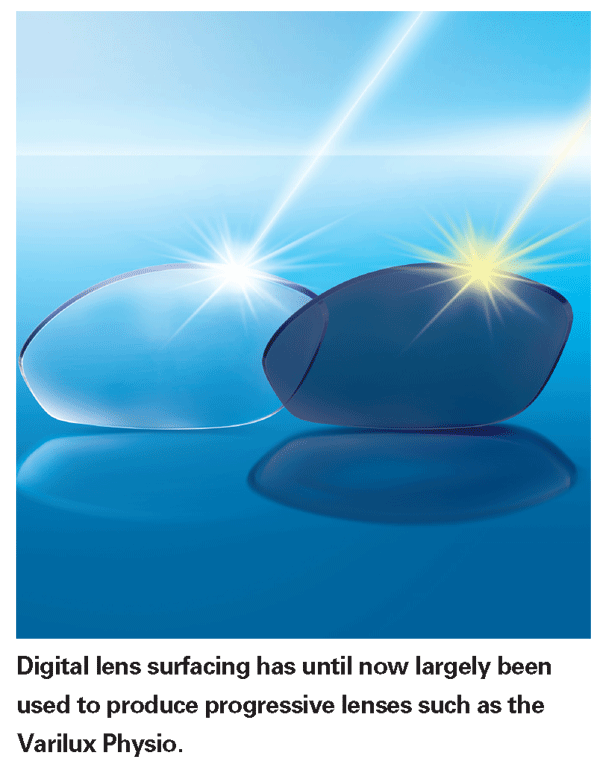Digital lens surfacing has emerged as the latest trend in dispensing, touted by experts as the future of optical lens finishing. While all indications are that this trend will have a significant impact on spectacle lenses and the patients who wear them, I have one thing to say to optical dispensers.
Relax; for a change, it seems that eye-care practices and eyewear dispensers do not need to change.
The lion's share of that falls in the laps of optical laboratories, who will need to reinvest in equipment that's new to the United States and costs in the neighborhood of $500,000, as well as hire or train operators who are more technically qualified.
These changes are expected to produce customized spectacle lenses that provide sharper, clearer vision, and are likely to become the gold standard among professional eye-care practices. 
In other words, digitally surfaced lenses will make you the hero, and there are some simple steps you can take now to get your practice and patients ready:
• Learn about this new technology so you can explain it to patients.
• Educate patients about what's available now, and what will be available in the not-too-distant future.
• Begin recommending digitally surfaced lenses to patients for whom they are appropriate.
• Find out where your lab stands on the changeover to digital surfacing.
• Gather whatever resources you need to keep your practice on the leading edge of this trend.
What It Is
Digital or direct surfacing is currently used for new progressive lenses such as the Varilux Physio. In time, the technology will also be applied to single-vision lenses.
Using equipment and software that has been widely used in
"In this way, aspheres, torics and complex surfaces can be added to improve vision and field of view. It's a great way to make a really good progressive even better," explains Mark Mattison-Shupnick, ABOM, manager of education and training for Jobson Medical Information, LLC, parent company of Review of Ophthalmology. Power, prism and design optimization can also be added to the front or back surface.
Digital surfacing also eliminates polishing in the traditional way. A new breed of generator uses diamond-tipped cutting tools to precisely prepare the lens surface. The final step is application of a soft and flexible pad that improves transparency, presumably making a crystal clear lens.
This equipment is made by just a few companies (DAC International, Optotech, Satisloh and Schneider Optical Machines), and cost anywhere from $300,000 to $1 million.
What Patients Need to Know
All patients need to know that this new technology will be producing better lenses that will provide sharper vision. They also need to know that you know—because they are likely to hear about it on the Internet, from other patients or even from another eyewear retailer. As a dispenser for an ophthalmology practice, you need to always appear to be ahead of the curve on technology.
Everyone knows about the digital revolution in music recording and in photography. Digital technology makes music sound more lifelike, and has transformed photos into a user-friendly medium. You can note that digital lens surfacing will bring similar benefits to eyewear consumers.
It only makes sense to start converting your progressive lens patients to digitally surfaced lenses, now offered by Varilux, Carl Zeiss, HOYA, Shamir, Signet Armorlite and Seiko. This will serve the purposes of: building your confidence in recommending digitally surfaced lenses; demonstrating to patients that you are staying with or ahead of trends; and educating patients about the new technology.
When you have a comfort level with these products, it's time to think way ahead of your competition. "Although digital surfacing technology has largely been used to produce PALs, it is capable of producing many other lens styles or designs," notes Katheryn Schramm, ABOM, owner of A Child's View, four pediatric optical boutiques in
Ms. Schramm says she has ordered specialty lenses for children and adults whose lives were literally transformed by the improved vision they experienced with digitally surfaced lenses.
Gather Resources
Let your optical lab know about your interest in this technology. If they aren't planning to re-tool, it may give them a nudge in the right direction. You certainly will need to establish a relationship with a lab that can take orders now for digitally surfaced progressives.
As for the more specialty lenses, there are few labs that will take these orders at this time. Ms. Schramm has worked directly with Quest Optical Specialty Lab in
Mr. Walach acquired many years of experience with digital surfacing in











